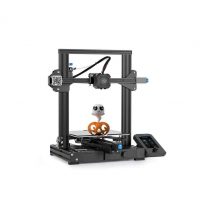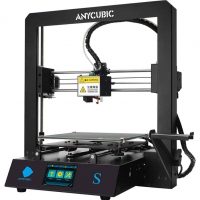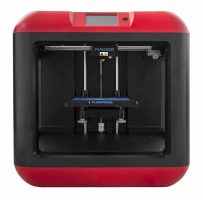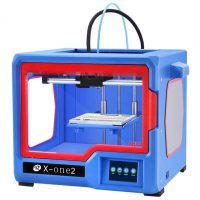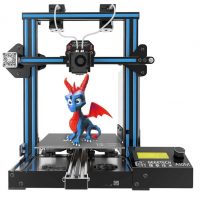Best 3D Printer Under $300 in 2021
3D printing on a modest budget
- Last Updated Apr 28, 2021
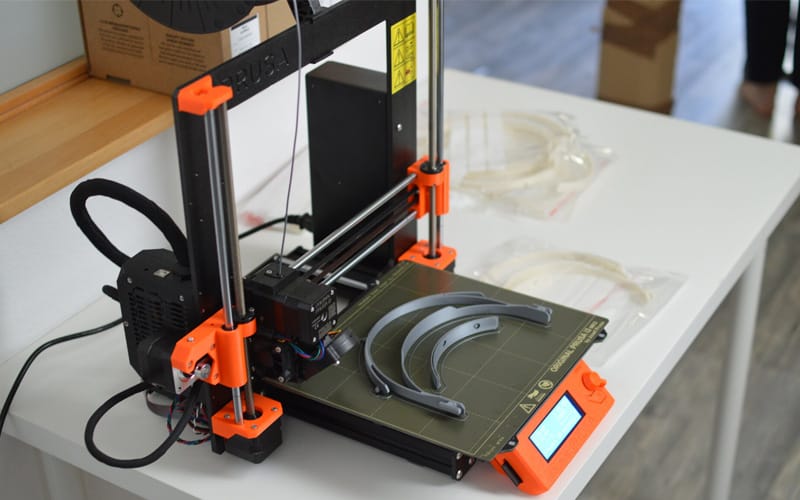
With 3D printing technology reaching relative maturity since its DIY-Kickstarter origins, the barrier of entry has lowered considerably. While the very best 3D printers stick cost a pretty penny, some of the better and useful technology has trickled down to lower-priced options. No longer is it a case of making some serious sacrifices to build quality, functionality, and features to keep costs down. A novice maker testing the waters for the first should find plenty to like in a budget printer.
That said, buying a $300 printer needs to come hand in hand with the right expectations. These are cheap, humble 3D printers. The reality is that they simply won’t perform as well as more expensive options, nor will you get the same convenient, user-friendly features, calibration, or versatility. Nevertheless, there’s plenty of value to be found here if you look in the right place.
To that end, we’ve trawled through the ever-swelling spread of 3D printers to pick out the very best priced under $300 and compiled them into this handy guide.
Products at a Glance
How We Picked
Ease of assembly, build quality and frame design, printing performance, build volume, calibration, connectivity, platform heating resolution, speed, and compatible materials/filament largely guided our decision-making process. In other words, all the factors that anyone on the hunt for a 3D printer should take into account.
While settling on the ‘best’ is a tricky task given how many printers under $300 are out there and how much needs and requirements vary from person to person, we’ve managed to whittle our choices down to five recommendations. The running theme among them is that they offer excellent value for money and can handle those modest, small-scale projects and produce prints of respectable quality. They are especially suited to first-timers or seasoned printers that want a reliable foundation to tinker and modify themselves.
Below, you’ll find a review for each of the five printers alongside pros and cons for those that want a quick take on each. Let’s jump in.
Best 3D Printer Under $300 in 2021
Superb print quality for the price
Ease of assembly and use
Decent build volume
Tricky filament loading
Creality is well known for producing low-priced but well-built 3D printers – indeed, the original Ender 3 is one of the best-selling printers around. Creality follows in that tradition with the updated and improved Creality Ender 3 V2, one of the best 3D printers under $300.
What makes the Creality Ender 3 V2 such a remarkable offering in this price range is the quality of the prints produced, virtually out-of-the-box (after the necessary manual bed leveling and assembly, of course). Whatever the size or shape, or complexity of the creation, or the supported filament types (PLA/TPU/PETG), the Creality Ender 3 V2 delivers.
A self-developed 32-bit mainboard and TMC2208 stepper motor drivers do much of the heavy lifting in this regard for more accurate, smoother movements. All this while keeping noise levels down to 50 dB for virtually silent printing, barring the fans’ hum and the directional hops of the drive train. With a 220 x 220 x 250 mm build volume, 100-400 micron layer height, and 100-micron printing resolution, the Creality Ender 3 V2 is also one of the more versatile printers under $300 in that it can churn out good detail in a range of sizes.
We also like the inclusion of a 100-degrees heated tempered carborundum glass print bed, sturdy all-metal body, concealed MeanWell power supply, tool draw, 4.3-inch detachable screen (although not a touch screen), and the XY-axis belt tension knob (great for keeping the belts taut and in tip-top condition).
The Creality Ender 3 V2 isn’t without its faults, though. Chiefly, the filament feeding solution is finicky. Both the positioning and size of the opening are to blame, and there will be some frustration involved for the first few attempts until you’ve mastered the process.
Print quality
Semi-assembled
Filament sensor
50 micron resolution
Loud printing
Build volume
The Anycubic Mega S is another 3D printer that successfully balances a sub-$300 price tag with impressive print quality and a generous feature set. Undoubtedly an entry-level printer, the Anycubic Mega S comes with its limitations, it has to be said. Still, there’s plenty here for beginners and even seasoned printers to sink their teeth into.
A solid full-metal frame, three-step easy assembly, a high-quality Titan extruder better suited to flexible filament, suspended filament spool holder, and 50 to 400-micron print resolution combine to offer easy up-and-start printing (after manual bed leveling). The results are invariably reasonable, surprising even for a $300 printer. The open design makes the Anycubic Mega S particularly suited to modification and tinkering.
The Anycubic Mega S also boasts quality of life features that have trickled down from much pricier printers, such as a filament sensor that includes run-out detection, an auto-resume function after power loss, and Anycubic’s impressive Ultrabase heated print bed (strong adhesion and easy removal of finished prints), and a full-color integrated touch screen.
As for the negatives, the Anycubic Mega S runs loud with both the fans and stepper motors combining to make quite a din, unlike the Creality Ender 3 V2, which is virtually inaudible by 3D printer standards. The build volume lags behind the Ender 3 as well, with a 210 x 210 x 205 mm print area. While Anycubic could have made some improvements here, these issues don’t take away from the fact that the Anycubic Mega S offers good print quality, excellent quality of life features, and broad material support (TPU, PLA, ABS, HIPS, Wood).
Ideal for beginners and easy to use
Removable build plate
Ships completely assembled
Connectivity
Limited to PLA filament
Small build volume
The FlashForge Finder is a strong option for beginners that want a fully-assembled plug-and-print 3D printer and are worried about accidentally dislodging or breaking components (wires, nozzle, belts, etc.) or inadvertently upsetting the printing process with an errant hand. With a semi-enclosed open-frame design, the FlashForge Finder comes in a sleek, housed package and is easily one of the more aesthetically cohesive printers in today’s guide, not to say safest.
Printing is smooth, reliable, and very quiet. The result is systematically very good for the price. The removable build plate is a nice touch that simplifies peeling off finished prints, and the 100 to 500-micron resolution offers respectable detail. The FlashForge Finder bundles in broad connectivity through either USB 2.0, USB thumb drive, Wi-Fi, and the 3.5-inch touch screen provides simple but responsive on-printer controls.
The FlashForge Finder does have its limitations, chiefly a small build volume – 140 x 140 x 140 mm. There’s no heated bed, no automatic bed leveling (although the leveling instructions are concise and easy to follow), nor filament detection. Filament support stops at PLA, with a bit of leeway for modest PETG prints.
For beginners experimenting for the first time, this shouldn’t be too much of an issue, but once you want to try your hand at more ambitious projects, you may find yourself outgrowing the FlashForge Finder. In that respect, experienced makers will struggle to find much to warrant buying the FlashForge Finder instead of one of the more versatile and adaptable 3D printers in our product guide.
Fully enclosed design
Out-of-the-box printing
Build volume
No auto-bed leveling
Limited connectivity
Another top plug-and-play 3D printer under $300 worth considering is the QIDI Technology X-one2. But unlike the FlashForge Finder, this one includes an almost fully enclosed-frame design (the top remains uncovered), ideal if you favor safety or want a controlled printing environment to manage temperatures and keep unpleasant ABS fumes contained to a certain extent.
Features include a resolution of 50 to 400 microns, MK10 extruder, a user-friendly 3.5-inch touch screen, a CNC aluminum alloy build, a heated build plate (110-degrees), support for PLA, TPU, ABS, PETG filament, and an SD card reader. Prints quality falls within a respectable range for the price, and you can expect smooth, detailed creations to come out reliably.
Much like the FlashForge Finder, the QIDI Technology X-one2 sacrifices build volume for plug-and-print ease of use, with an underwhelming 145 x 145 x 145 mm build area. Similarly, the printer lacks auto-bed leveling, although the setup is reasonably straightforward – feed-in filament, adjust a few screws to level the bed, and you’re ready to go.
Dual extrusion
Multi-color/multi-material printing
Build volume
Auto bed levelling
Loud
Dual extrusion tends to be reserved for much pricier models. However, Giantarm has successfully managed to integrate the feature into the sub-$300 Giantarm Geeetech A10M 3D printer without compromising on other aspects of the machine. If anything, the printer boasts one of the best feature sets for under $300, which sees it flirt with the Creality Ender 3 V2 and Anycubic Mega S in terms of value for the money.
The main attraction is, of course, the dual extrusion, which allows printing in multiple colors (with different modes including graded color and mixed color) and materials (PLA, ABS, PVA, HIPS, PETG, Wood). The results are exceptional for the price, and even complex, graded color or patterned prints come out smooth and well-detailed.
Another area where the Giantarm Geeetech A10M shines is the inclusion of features that feel entirely out of place given its low price tag. Power outage auto-resume, filament detection, quiet V-frame rails, heated silicon carbide build plate, and auto-leveling – all excellent and desirable quality of life features that typically cost a lot more. Alongside, it features an A10M extruder with 360-degree ventilation for better heat dissipation, 220 x 220 x 260 mm build volume, 100-micron resolution, Wi-Fi, USB, and SD card connectivity, and LCD.
While the Giantarm Geeetech A10M ships part pre-assembled, setting it up is easy (connect wires and combine five parts) and well-guided thanks to clear instructions.
The only real complaint is the loud operation, and the open-frame design isn’t particularly suited to ABS prints.
Things To Consider
Our Verdict
Our top recommendation for 3D printers under $300 is the Creality Ender 3 V2. A best seller for a good reason, it offers excellent print quality for the price, is easy to assemble, near-silent, and packages in a decent build volume.
Similarly impressive is the Anycubic Mega S. With good print quality, an enviable feature set including some choice quality of life specifications, beginners and seasoned makers should find plenty of value in this 3D printer.
For plug-and-print ease of use, it’s hard to go wrong with the sleek FlashForge Finder. The filament range is limited, but the printer makes up for this with reliable printing performance, superb connectivity, and plenty to please beginners that want to get up and print as soon as possible.
Those looking for an enclosed 3D printer should consider the QIDI Technology X-one2. Safe, versatile, and reliable, it’s a strong option for novices that want easy out-of-the-box printing.
Finally, our dual extrusion pick, the Giantarm Geeetech A10M, is hard to beat and has a feature set usually reserved for more expensive 3D printers, including auto-leveling and a generous 220 x 220 x 260 mm build volume for the price.
We’ll now wrap up our guide to the best 3D printers under $300. Feel free to drop into the comments section below with any questions or recommendations of your own.

